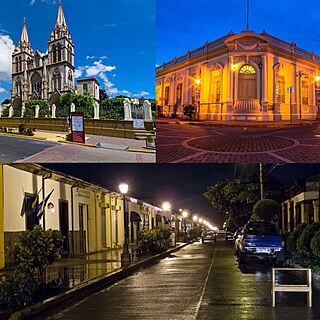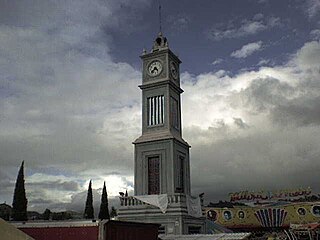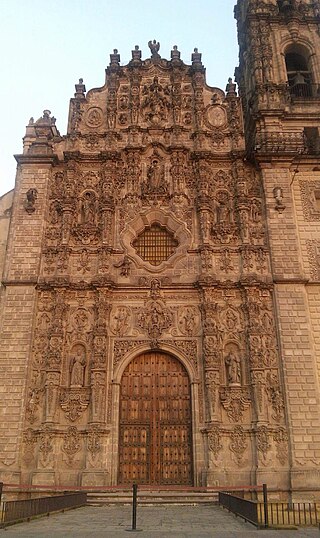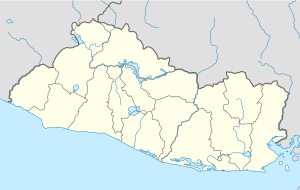History
Opico was established as an Indian village in 1572 and received the title of town in 1881.
Administrative divisions
It has 27 cantons: San Jose la Cueva, Talcualuya, El Castillo, Buena Vista, Nombre de Dios, San Antonio, San Pedro Martir, Tehuicho, Barranca Honda, Los Amates, Pitichorro, Nueva Encarnación, Chantusnene, San Nicolás Encarnación, Minas de Plomo, San Pedro Oriente, San Felipe, Los Encuentros, Agua Escondida, Lomas de Santiago, Joya de Ceren, Sitio del Niño, Chanmico, Matazano, Sitio Grande, El Jabali, Las Delicias, and Las Granadillas.

Joya de Cerén is an archaeological site in La Libertad Department, El Salvador, featuring a pre-Columbian Maya farming village. The ancient Maya site of Joya de Cerén is located in the Zapotitán Valley, 36 kilometers northwest of San Salvador, El Salvador. It is often referred to as the "Pompeii of the Americas", in comparison to the famed Ancient Roman ruins.
San Rafael Obrajuelo is a municipality in the department of La Paz, El Salvador. As of 2017 it was estimated to have a population of 11,403.

Nuevo Cuscatlán is a municipality of El Salvador, belonging to the department of La Libertad, it is located 13 kilometers from San Salvador. It borders to the north and east with Antiguo Cuscatlán, to the south with Huizúcar and San José Villanueva and to the west with Santa Tecla.

Concepción de Ataco is a municipality and city within the Ahuachapán Department, El Salvador. It has an area of 61.03 km ² and a population of 18,101 inhabitants.

Santa Tecla is a municipality in the La Libertad department of El Salvador. It is the capital of the department of La Libertad.

Ciudad Nicolás Romero is the largest city and municipal seat of the municipality of Nicolás Romero in State of Mexico, Mexico. It is located 58 km from the city of Toluca, the state capital and lies in the north-central part of the state, just northwest of the Federal District. The seat/municipality's current name is to honor Nicolás Romero, who fought for Benito Juárez during the Reform War and the French intervention in Mexico. He was executed there by the French. The town adopted this name in 1898. The area was settled by the Otomi and named Azcapotzaltongo by the Aztecs after conquering it. During colonial times, it was known as San Pedro Azcapotzaltongo. It was then called Monte Bajo from 1821 to 1898, when the current name was adopted. Both the municipality and city are commonly referred to as Nicolás Romero.

San Juan Bautista Tuxtepec, or simply referred to as Tuxtepec, is the head of the municipality by the same name and is the second most populous city of the Mexican state of Oaxaca. It is part of the Tuxtepec District of the Papaloapan Region. As of the 2020 census, the city is home to a population of 103,609 and 159,452 in the municipality, though census data are often under reported for various reasons. The municipality resides in the region called La Cuenca, is located 36 feet above sea level, and occupies an area of approximately 580 square miles (1,500 km2). The city itself is surrounded by the Papaloapan River, and lies a few kilometers south of the Cerro de Oro Dam on its tributary the Santo Domingo River. The municipality is bordered by the state of Veracruz in the north, the municipalities of Loma Bonita to the east and San José Chiltepec to the south. It is almost 100 miles (160 km) to the port of Veracruz, 130 miles (210 km) to Oaxaca City, the state capital, and 310 miles (500 km) to Mexico City.

Encarnación de Díaz is a town and municipality located in the far northeast of the state of Jalisco in north-central Mexico. It is located in a natural pass that connects the Los Altos region of Jalisco to points north, and from pre-Hispanic times until the 20th century, it was a major thoroughfare for north-south travel. The town began as a way station along a road built through this pass in the 17th century, formally becoming a town in 1760. It began to function as a municipality in the latter 19th century, but this status was not confirmed until the early 20th. Transport, along with numerous prosperous haciendas supported the economy of the area until the early 20th century, when travel patterns and the Mexican Revolution spurred its decline. In the 1920s, it was a centre of rebellion during the Cristero War, and the town contains Mexico's only museum exclusively dedicated to this episode in history. It also contains a museum dedicated to various naturally occurring mummies which have been found in the municipal cemetery.

Jerécuaro is a Mexican city located in the lowlands of the state of Guanajuato. The municipality has an area of 828.3 square kilometres and is bordered to the north by Apaseo el Alto, to the east by Coroneo and the state of Querétaro, to the south by Tarandacuao, to the southwest with Acámbaro, and to the northwest with Tarimoro. The municipality had 55,311 inhabitants according to the 2005 census. The municipal president of Jerécuaro and its many smaller outlying communities is C.Jaime García Cardona.

Salvadorans, also known as Salvadorians, are citizens of El Salvador, a country in Central America. Most Salvadorans live in El Salvador, although there is also a significant Salvadoran diaspora, particularly in the United States, with smaller communities in other countries around the world.

Tlaxiaco is a city, and its surrounding municipality of the same name, in the Mexican state of Oaxaca. It is located in the Tlaxiaco District in the south of the Mixteca Region, with a population of about 17,450.
El Carrizal is a municipality located in the department of Chalatenango in the North of El Salvador.

Tepotzotlán is a city and a municipality in the Mexican state of Mexico. It is located 40 km (25 mi) northeast of Mexico City about a 45-minute drive along the Mexico City-Querétaro at marker number 41. In Aztec times, the area was the center of a dominion that negotiated to keep most of its independence in return with being allied with the Aztec Triple Alliance. Later, it would also be part of a "Republic of the Indians," allowing for some autonomy under Spanish rule as well. The town became a major educational center during the colonial period when the Jesuits established the College of San Francisco Javier. The college complex that grew from its beginnings in 1580 would remain an educational center until 1914. Today this complex houses the Museo del Virreinato, with one of the largest collections of art and other objects from this time period.
Club Deportivo Juventud Independiente, also commonly known as Juventud Independiente, is a professional Salvadoran football club, based in San Juan Opico, La Libertad, El Salvador. Founded on 7 September 1943, holding home matches at Complejo Municipal. The one time primera division side enjoyed its greatest successes in the 2010s, but following financial troubles and selling their spot to Luis Ángel Firpo, the club currently plays in the 4th division, Tercera División.

Santiago Papasquiaro is one of the 39 municipalities of Durango, in north-western Mexico. The municipal seat lies at Santiago Papasquiaro. The municipality covers an area of 7,238.4 km². Santiago Papasquiaro municipality is at an average height of 1,730 m (5,675 ft) over the sea level. The municipality lies east of Sierra Madre Occidental Mountain Range. It neighbors with other municipalities: Canelas and Tepehuanes municipalities at the north; San Dimas and Otáez, south; Nuevo Ideal to the east, Tamazula to the west and El Oro located northeast.
Óscar Elías Cerén Delgado is a Salvadoran professional footballer who plays as a midfielder for Salvadoran club A.D. Isidro Metapán.

Tourism accounts for a large part of El Salvador's economy. El Salvador has many natural attractions including beaches with some of the best surfing breaks on the Pacific Coast. El Salvador offers many lush forests shrouded in cool temperatures with abundant wildlife and scenic mountain-top vistas. El Salvador also has great potential in the field of cultural tourism; with over 2,000 known archaeological sites, mostly of the Maya and Olmec cultures. These sites are of international interest for their easy access and well preserved remains.
Brenda Damaris Cerén Delgado is a Salvadoran footballer who plays as a forward for Alianza FC and El Salvador women's national team.

Kanasín is a city in the Mexican state of Yucatán and the municipal seat of the municipality of the same name. It is located in the northwestern region of the state, forming part of the Mérida metropolitan area. According to the 2020 census carried out by the National Institute of Statistics and Geography (INEGI), it had a population of 139,753, making it the second largest Yucatecan city after Mérida, the 8th most populous in southeastern Mexico and the 101st most populous in the country.

















